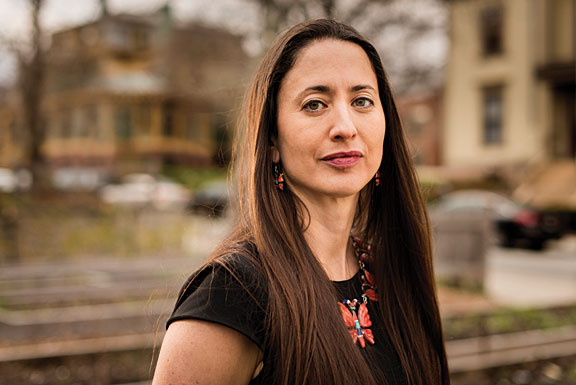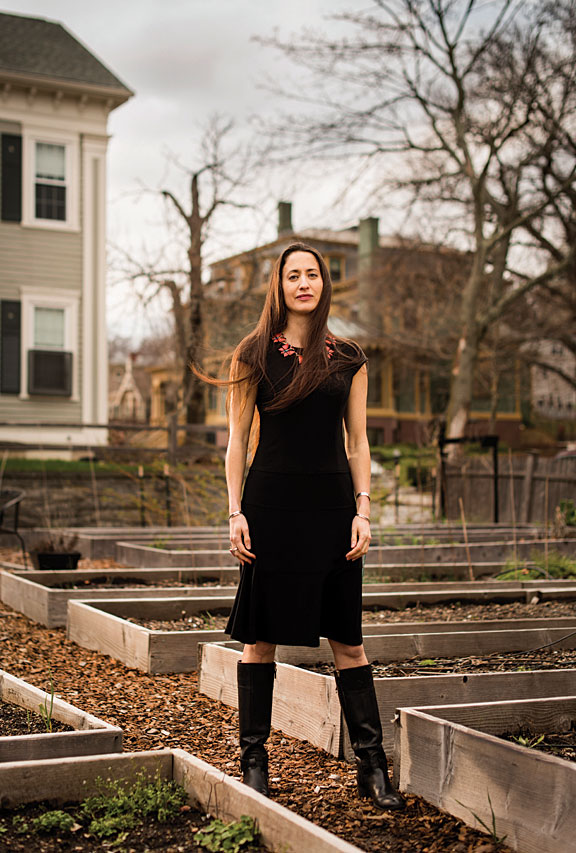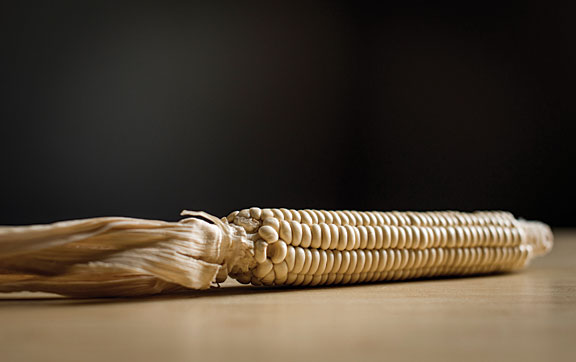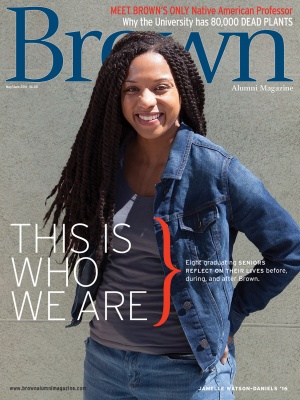Elizabeth Hoover ’03 AM, ’10 PhD, planned to become a farmer. As a high school student growing up in an upstate New York town, she was all set to attend the local SUNY agricultural school after graduation. Until, that is, Mrs. Munson intervened.

“Farming is failing in New York State,” said Mrs. Munson, her high school’s guidance counselor. Even people inheriting farms weren’t making it. Think bigger, she urged. Noting that Hoover was good at social studies, Munson talked her into applying to Williams College, where she might pursue a degree in anthropology.
“It seemed like an impossible reach,” Hoover recalls. Her family was taken aback by the cost of tuition. But she applied and was accepted. Munson helped her fill out the financial aid forms.
A dozen years later, having graduated from Williams and gotten her master’s and Ph.D. from Brown, Hoover was reflecting on Munson’s impact on her life. So she wrote her a letter. “Instead of a failing farmer,” she said, “I am now a doctor of anthropology.” Hoover didn’t know that Munson had long ago left teaching to raise her kids, and that when Hoover’s letter arrived, she was about to try to resume her career. Hoover offered to write a letter of recommendation for her, delighted she could give back to the counselor who had set her on the path to academia.
She is now the Manning Assistant Professor of American Studies—and until this year Brown’s only faculty member of Native American descent [2024 editor’s note: Hoover retracted her claim to Native American heritage in 2022, and released a more extensive apology in 2023. Joukowsky Family Assistant Professor of American Studies Adrienne Keen, a former friend and colleague of Hoover’s, published this letter in 2023 in response to Hoover’s apology. The New Yorker published this long report on Hoover and the issue of identity in 2024].
Hoover is a social scientist who works on issues of environmental health and justice, primarily in Native American communities. Her first book, “The River Is in Us”: Fighting Toxins in a Mohawk Community, which is in peer review at the University of Minnesota Press, is a study of how a Mohawk community in upstate New York responded to health problems stemming from corporate environmental pollution.
“Imagine the story of Flint, Michigan, set on an Indian reservation, and add even more corporate intrigue,” says American Studies department chair Matthew Guterl, who calls the book a “thoughtful scholarly analysis” that, while focusing on Native Americans in a specific locality, may have national impact on public policy and on how public-health research is conducted. In this case, due to the organizing efforts of members of the Mohawk community, scientists and community members worked together in a way that benefited both the quality of the research and the research subjects themselves. Hoover analyzes the formation of the social justice movement that arose on the reservation, the changes in methodologies adopted by the scientists, the positive effects of these developments on both the Mohawks and the attitudes and practices of the scientists, and the implications for future public-health research.
While “The River Is in Us,” which grew out of her doctoral dissertation, is a local study, Hoover’s current research is national in scope. She’s looking at how dozens of different reservations and urban communities are organizing in response to the high levels of heart disease, obesity, and diabetes among Native Americans, as well as their connection to the cheap and easy diet of low-income America. Again drawing from the fields of environmental and medical anthropology, biology, public health, and political science, Hoover is analyzing the variety of local, grassroots efforts to get tribe members to change their diet for the better—including some of the economic and logistical challenges to the Native American version of the national local-food movement. She is also studying how those public-health initiatives intertwine with efforts toward “food sovereignty”—the desire among some Native Americans to have their tribes become independent of the national food industry—and the related emphasis on returning to traditional tribal diets, crops, and heritage seeds. She’s particularly interested in how these movements arise culturally—which is happening in indigenous communities across the globe—and the ramifications of this kind of community organizing on politics, economics, and public health.
Hoover’s expertise recently got the attention of the Smithsonian, which tapped her to write a chapter on the food sovereignty movement for the institution’s latest edition of its reference series on the American Indian, “the ultimate resource for Native American history.”
The combination of Hoover’s PhD in anthropology and her Native American heritage—she’s part Mohawk and part Mi’kmaq, among other things [Editor’s note: This is not true, see note above. Hoover does not have Native American ancestry.]—allows her to bring to her work both the intellectual rigor of an academic and, crucially, the cultural understanding of someone who is from two of the tribes she studies. What also distinguishes Hoover is how she brings her scholarship out of the academy and into the real world. She’s particularly interested in applied work—scholarly research that has the potential to have a direct and immediate impact on people’s lives. As a coleader of the Community Engagement Core of Brown’s Superfund Research Program, for example, Hoover is addressing environmental health and remediation concerns in the state of Rhode Island.
Hoover’s teaching follows the same principles of engaged scholarship. Rather than just sitting in a classroom, her students go out into Providence and surrounding areas to conduct such original research as working with local farms to document and analyze consumer reactions to community-supported agriculture (CSA) programs, or interviewing local contractors about the effectiveness of a statewide childhood lead-poisoning prevention program. Future doctors and lawyers value Hoover’s class on community research because its information is vital to their fields. Before they can conduct medical research on members of a particular community, they must not only know the laws governing such research but also be sensitive to evolving ethics, which increasingly emphasize the need to involve residents.
Hoover’s class introduces students to social and political developments that affect research methodologies and the possibility of conducting the research at all—or, as Hoover puts it, “why communities are saying, ‘No, you’re not going to study us like guinea pigs.’” In the past, scientists investigating such public-health issues as the effects of environmental pollution have taken up people’s time, drawn their blood, then often left them with serious medical issues and a lot of unanswered questions. Increasingly, low-income and minority communities are demanding that research subjects be better informed about the potential benefits and limitations of environmental and health research conducted on them, and that the researchers take their unique culture into consideration and involve them as true partners.
Hoover trains her students in both traditional and alternative methodologies, and their classwork has real impact. Local organizations have used Brown student reports to apply for grants and develop new or improved programming. Hoover’s teaching won her the Dean’s Award for Excellence last year and has been spotlighted by the Swearer Center for Public Service as an example of the kind of engaged scholarship that is a key component of Brown’s mission.
THE ACADEMICS OF URGENCY
Hoover’s original academic interest was a bit more esoteric: she came to Brown to do graduate work in anthropology and museum studies. After earning her master’s degree, however, she changed paths. “Museums felt interesting but not urgent to me,” she says, though she remains a faculty associate at the Haffenreffer Museum of Anthropology.
As Hoover began working on her PhD, she became increasingly drawn to the work of a Mohawk friend, Katsi Cook, who, Hoover says, had “basically revolutionized how environmental research was done.” Cook, a midwife in the Akwesasne territory along the St. Lawrence River in upstate New York and parts of Canada, wanted to know if it was safe for her to encourage mothers to breastfeed their babies while eating their traditional food: fish from the St. Lawrence, which had long been contaminated with PCBs from three Superfund sites. (There was also an aluminum factory nearby whose smokestacks introduced even more pollutants into the environment.) After much prodding, Cook had convinced researchers from SUNY-Albany to study the breast milk of women from the tribe. But Cook believed that the women should be not merely research subjects but active participants in the research itself. Hoover says Cook told the researchers, “You’re going to train Mohawk women to collect samples from other Mohawk women.”

The SUNY scientists reported that they’d learned a lot about how to work with the subjects of their research in a more respectful and ultimately more productive way. “It really set the example for future research,” Hoover says. Not only did the Akwesasne benefit from the information gathered; the women got valuable job skills. “Some of the Mohawk women who were trained to collect the breast milk and blood samples went on to use that education and got more, and ended up in health care jobs,” Hoover says. “The study was innovative, too, in that people from the Akwesasne community were included as coauthors.” Hoover’s study of the Akwesasne project became the basis for her doctoral dissertation and the topic of her first book.
It was while studying the Akwesasne that Hoover became interested in Native American food movements. A group called Kanenhi:io Ionkwaienthon:hakie, which in the Mohawk language means “We Are Planting Good Seeds,” was working to educate the Akwesasne about the relationship between diet and health and inspire them to grow their own healthful food. Considering that Native Americans have almost three times the rate of diabetes than the overall U.S. population, for example, to Hoover it’s crucial work, with important implications for such issues as preserving cultural practices and heritage plant varieties.
Food activism can be complicated, however. Is it safe to plant seeds in what might be toxic soil? Is it more cost-effective to plant a garden with heirloom vegetables or to get hybrid seeds and buy fresh produce at Walmart? Hoover wanted to see how other Native American communities were addressing these types of issues. In 2014, she received a Salomon Faculty Research Award to pursue that research, so that summer, she says, “I just jumped in the car and drove twenty thousand miles.” With additional support from the Ford Foundation, Hoover visited forty-one different Native American communities, both urban and rural, gathering research for her second book project, From ‘Garden Warriors’ to ‘Good Seeds’: Indigenizing the Local Food Movement. (See photos and dispatches from her 2014 research trip at gardenwarriorgoodseeds.com.)
In some cases, Hoover says, gardening is about returning to tribal ways, while in the case of others, such as the Lakota people, who did not traditionally garden, growing their own food is more about improving health and gaining a degree of sovereignty. And returning to farming traditions can involve historical, anthropological, and scientific detective work. Hoover explains how one activist, for example, had read descriptions of speckled corn planted by the Ponca tribe in the 1800s, and tried to track it down. The Ponca tribe had been routed from its homeland in Nebraska in 1877, but a Lakota family had harvested some of the corn that was left behind and saved the seeds for generations, even though they had become mixed with other corn varieties. Recently, a farmer was able to isolate some of the genes of the original Ponca corn and give it back to the tribe.
Hoover’s expertise on Native American environmental health and food sovereignty has led not only to her work for the Smithsonian Institute but also to invitations to speak at schools such as Yale and organizations such as the National Institutes of Health. Meanwhile, back on campus, Brown’s Urban Environmental Lab recently offered garden space to Hoover and students from Native Americans at Brown for planting heritage seeds—a twist on her original dream of farming. This May, however, Hoover is attending academic conferences in California, Hawaii, and New Zealand. “I will have to try to plant when I get back,” she says, “depending on the number of students who are around for the summer.”
NATIVE AMERICANS AT BROWN
Though Hoover is an expert on Native American communities and, in her extracurricular hours, has been instrumental in building one at Brown, she herself didn’t grow up in one. She was raised in a mostly white town and says, “We created community by going to it.” Throughout her childhood, her mom would take the family to various powwows throughout the region. Elizabeth became a fancy shawl dancer, an athletic Native American art she learned from other women there. Fancy shawl dancers wear large, fringed, and often beaded shawls, performing kicks and elaborate, high-impact footwork to the beat of traditional drums, and spinning like the butterflies they are said to represent. “Beadworker” is another item on Hoover’s bio, as she also learned to create her own outfits.
When Hoover got to Williams, she found that the few other Native American students had not pulled together into the kind of community she’d grown to appreciate at the powwows. So she organized the college’s first powwow. “It was so much work,” she recalls. “I told myself I’m never doing that again.” When she arrived on College Hill for grad school, however, she joined NAB and soon other members were asking her to help organize a powwow on campus. Somewhat reluctantly, she agreed.
The inaugural event, held in Sayles Hall in 2001, was just “bursting at the seams,” Hoover says. Students, family members, and people from the Rhode Island community attended the event. This year’s fifteenth-anniversary Spring Thaw Powwow, held on the College Green on April 23, featured dance contests, drummers, and Native American food and arts and crafts vendors. Hoover danced, jumping and twirling in her fancy shawl regalia, before dashing off to her round of academic conferences.
In addition to enriching the experience of Native American students, the annual powwow has been good for the University, Hoover says. “It’s really improved the relationship between Brown and the local Native community.” Before, she explains, Brown was perceived by many local Native Americans as “an elitist, snobby institution sitting on Native land, not wanting anything to do with us.” While the majority of Native American undergrads at Brown are from tribes in the Southwest, Hoover and the other organizers make sure to include the traditional dances of local New England tribes. As a result, the powwow has become a popular regional event.
Meanwhile, fifteen years after planning the first powwow with other Native American students in the NAB office on the second floor of the American Studies house on Power Street, Hoover is still working in that same room, now her office. NAB has moved across campus to the Brown Center for Students of Color on Waterman Street. Hoover describes herself as an unofficial “den mother” to the student group, which meets every Thursday evening. Being NAB’s faculty adviser can be a balancing act, Hoover admits, because she teaches many of the members: “When they’re in my classes, I’m their professor,” she says. “But when I’m in the NAB space I don’t bug them about classwork, even if I know they owe me something.”

Taped to the walls of the former NAB office are colorful posters from various Native American events. There Hoover makes tea, selecting a bag from a café-worthy collection of boxes, looking amazingly calm considering her book deadline is upon her. Her reading for the day is on her desk: a stack of sixteen books by other social scientists, which she’s planning to skim through for ideas on how to write her introduction.
Hoover is also trying to move the University closer to one of her longtime goals: creating a Native American and Indigenous Studies concentration. She meets regularly with a working group of nineteen faculty members from a variety of disciplines, from history to religion and including such specialties as Mesoamerican studies and the study of indigenous Australians. The group is trying to come up with what the proposed concentration’s courses would look like. They recently received a grant from the Center for the Study of Race and Ethnicity to continue their work, and in the meantime the provost’s office has formed a separate Native American and Indigenous Studies initiative, with its own set of meetings for Hoover to attend.
Hoover has a few things to celebrate this year, in addition to the powwow’s fifteenth anniversary. Her first book is finished, and most of the field work for her second book is done. Her colleague Adrienne Keene, a Presidential Postdoctoral Fellow from Harvard who is a member of the Cherokee nation and who has been teaching Brown courses such as “Intro to Native American Studies,” will join the American Studies department as an assistant professor this summer. In addition to bolstering Brown’s Native American Studies course offerings, Keene’s hire means that Hoover is no longer the lone Native American on the Brown faculty. In fact, soon there will be three, due to a pending assistant-professor hire in the Theater and Performance Studies Department this fall. Earlier this school year, NAB successfully lobbied the faculty to have Fall Weekend, formerly Columbus Day, renamed Indigenous Peoples Day. Meanwhile, a new position—coordinator for Native American and Indigenous Studies—has been created that might relieve Hoover of some of her volunteer work.
She welcomes the help, but she keeps thinking of new projects. Lately, with some other Native American alumni, Hoover has been trying to organize a Brown Native American alumni group and she encourages any interested alums to contact her. “I think that it’s all wrapped up together,” she says. “Advocacy, research, building community.”
And the dancing?
Hoover smiles. “The dance is something I do to keep myself sane.”
Louise Sloan is the BAM's deputy editor.




